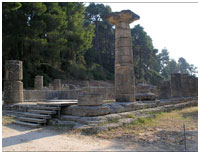Olympia
Olympia was an important site of the most famous games in history, Olympic games. The first games dated back in 776 BC as they prepared a festival to honor Zeus. It is however believed that the games are much older dating back to 10th century BC. Olympia is located on the western edge of the Greek Peloponnese and it became a center of worship of Zeus and Hera. The sanctuary spread on the natural terrace of Kronion hill, at the conjunction of the rivers Alfeios and Kladeos. At that time, the valley was full of olive trees, oaks, pines and plane trees, and we can only imagine how spectacular the sight was.
Myths of gods and heroes
According to mythology, the olympic games were founded by Zeus himself as a memory for the victory over his father and the Titans. It is unknown why the event was held every four years. The closest idea comes from a myth of the hero Heracles who had won a race at Olympia and then commanded that the race should be repeated every four years. Winners were crowned with a branch of crown-shaped olive tree that stood near the temple of Zeus. This crown shined the greatest honor on the athlete, his family and his native city.
Monuments of Ancient Olympia
At the start of 700BC, major changes took place on the site itself, including leveling ground and digging new wells. By the 600BC they had built the Temple of Hera, treasuries and Pelopion, a tomb of Pelops. They also started on projects such as stadium, athletic arenas and other non-religious buildings. The first stadium was built around 560BC. During the classical period they had built the Temple of Zeus which was constructed in respected size to honor the King of Gods. It was the biggest and most amazing building at that time. By the time 420BC sculptor Phidias built the statue of Zeus at the western end of the Temple. It was thirteen meters tall and was made out of ivory and gold. Further sport facilities were built and the old stadium was reconstructed and upgraded by increasing sloping sides for spectators. It had a capacity for about twenty thousand spectators. They had also built the first Hippodrome for chariot racing and Prytaneion on the north west side of the site, a building where officials and winners of Olympic games could meet. The Prytaneion normally stood in the agora which was at the heart of the city, usually in the center. The structure itself contained a holy fire of Hestia, a goddess of the heart, domestic affairs and home. In 400BC, they had also built a complex of houses around the treasuries which was called Metroon. During Hellenistic period, the largest ever building on site was constructed as a guest house for noble men. It was called the Leonidaion. They had also built the only monument constructed to man. It was called Philippeion. It was a circular memorial of ivory and gold which contained statues of Philip's family; Alexander the Great, Amyntas III, Eurydice and Olympias. Due to the increasing reputation and importance of the Olympic games, further athletic structures were built including the Palaestra, a school for wrestling and boxing, Gymnasium, a training facility for competitors in public games, and bath houses.



